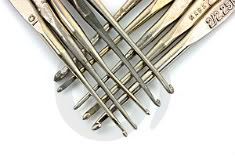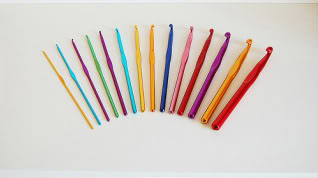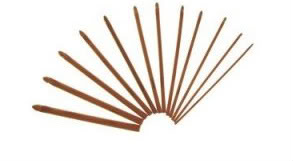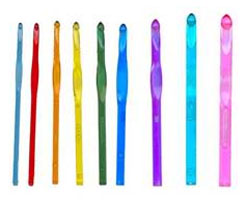Hooks are for Crochet, Not for Swordfighting
By Erin Burger – 9 CommentsWhen I was a little girl I was obsessed with my grandma’s crochet hooks. There were so many different sizes, colors and in a few cases, different shapes. My favorite was a large size N aluminum hook in Gold. I thought it looked more like jewelry than a tool for making afghans and also made for an awesome (and blunt) sword.
She quit crocheting when I was in my late teens due to arthritis and gave me all of her hooks and supplies. I spent lots of days getting them out, looking them over and playing around with them, but never learned to use them. Later, while on bedrest with my second daughter, I finally learned.
At first everything I made was completely incorrectly sized, mainly due to the fact that I insisted on using the shiny gold hook for every pattern I was trying to make¸ regardless of what size hook the pattern called for. Soon I learned the difference between the hooks I found in the large tin box, and which ones I preferred over the rest.
STEEL HOOKS:

There were lots of thin steel hooks in my grandma’s collection, which she mainly used for making doilies or similar lacework. I use small steel hooks for making appliqué with lace yarn or fingering yarn and when using those yarns for thin, stretchy items like headbands in cotton/linen mix.
Here are the sizes of Steel Hooks (in Millimeter and their corresponding U.S. Sizes usually both listed on hooks):
Crochet Hook Sizes
| Millimeter | U.S. Size |
| .75 mm | 14 |
| .85 mm | 13 |
| 1.0 mm | 12 |
| 1.1 mm | 11 |
| 1.3 mm | 10 |
| 1.4 mm | 9 |
| 1.5 mm | 8 |
| 1.65 mm | 7 |
| 1.8 mm | 6 |
| 1.9 mm | 5 |
| 2.0 mm | 4 |
| 2.1 mm | 3 |
| 2.25 mm | 2 |
| 2.75 mm | 1 |
| 3.25 mm | 0 |
| 3.5 mm | 00 |
ALUMINUM HOOKS:

My favorites (of course) were the many colored Bates and Boyes aluminum hooks. Those two brands run a monopoly on aluminum crochet hooks and have very subtle differences. I crochet every day and hardly notice the difference, aside from the actual brand name on the hook. A completely thorough look shows Bates hooks are ‘inline’ hooks, which means the head of the hook is ‘inline’ with the rest of the hook. Boyes hooks are ‘tapered’, which means there is a taper between the head and body of the hook. I’ve never read a pattern that called specifically for a Bates or Boyes hook in particular, so as long as you have the correct size, I wouldn’t fret over ‘inline’ and ‘tapered’.
Here are the sizes of Aluminum Hooks (in Millimeter and their corresponding U.S. Sizes usually both listed on hooks):
Crochet Hook Sizes
| Millimeter | U.S. Size |
| 2.25 mm | B-1 |
| 2.75 mm | C-2 |
| 3.25 mm | D-3 |
| 3.5 mm | E-4 |
| 3.75 mm | F-5 |
| 4 mm | G-6 |
| 4.5 mm | 7 |
| 5 mm | H-8 |
| 5.5 mm | I-9 |
| 6 mm | J-10 |
| 6.5 mm | K-10 1/2 |
| 8 mm | L-11 |
| 9 mm | M/N-13 |
| 10 mm | N/P-15 |
| 15 mm | P/Q |
| 16 mm | Q |
| 19 mm | S |
BAMBOO AND ACRYLIC HOOKS:
 |
 |
Bamboo hooks are popular because of how light they are, some being up to 60% lighter than aluminum hooks and although acrylic hooks might not be as light as bamboo; the average person wouldn’t be able to tell the difference between their weights. They both come in the same sizes as aluminum hooks. I personally don’t like using these two types of hooks because of their insubstantial weight; I find it difficult to keep the same tension throughout a row.
HELPFUL HOOK HINTS:
- A smaller hook will not only make a small stitch but will also make a thinner finished product. If you’re making an afghan an E sized steel hook isn’t going to give you a thick result. For warm afghans the bigger the better!
- Some yarns and certain size hooks go hand in hand. For example, I have found that a fingering yarn made of an organic material like Peruvian Wool just can’t be used with a hook bigger than G, unless you have a project that has lots of open work and is very thin and delicate.
- Want to make a hat? Worsted or DK weight yarn and a H hook have never let me down!
- See Types of Yarn and Recommended Crochet Hooks and Gauges for more information on project sizing and corresponding yarn weights and hook sizes.
- If you’re working on a garment or a something detailed and size is important, pay attention to your gauge! See What the Heck is a Gauge for more information on getting gauging right.
- Look for hooks at yard and garage sales. It almost never fails that someone’s going to have some.
- You can never have enough crochet hooks. On average I lose at least one hook a week, not to mention how many get taken by my children for playthings.
Have anymore hook related tips? Share here in the comments of this post!


Erin! Lovely writeup!
Good to know about the weight differences of the bamboo and acrylic. Since I love the feel of crochetting with my aluminum hooks, I won’t be wanting to experiment with other hooks.
Although it is totally logical, I had not thought of the smaller hooks producing a thinner, hence cooler, fabric. Since I am usually wanting to make things that are cool, I often wonder why in the world I love to crochet — so much of it is done with yarns for warmth! Your pointing out the obvious helps me to establish my projects for the future.
Thank you so much!
I think it’s amazing that steel and aluminum hook sizes have some overlap in sizes! I’ve always been afraid of those itty bitty hooks, but now I find out that i’ve been using the biggest steel hook size for quite a while, in the form of an E aluminum hook! Thank you so much for this educational post! I’m going to go get my unused steel hooks and tackle some itty bitty stitches!
I absolutely love my bamboo hooks! They just feel so smooth & nice, and I don’t notice a weight difference since aluminum hooks are already very lightweight (but the larger acrylic & plastic hooks do have more weight to them!). What I love most about the bamboo hooks is they’re never cold — which can be a big issue to me since I crochet anywhere and everywhere, including outdoors in cold weather (like when I’m waiting for a bus).
I prefer Boye hooks — small steel ones, and medium-sized aluminum ones. [I only have one large hook, and it’s plastic.] The hook I grew up using for every single thing I made was a gold aluminum Boye size H. My preferred hook for making baby blankets now is a blue aluminum Boye size G/6-4.25. [I actually have three each of the sizes G and H.] My new favorite for embroidery floss work is a steel Boye size 2/2.25mm. I do NOT like inline hooks — I recently visited four separate shoppes before finding the hook size I wanted with a tapered head.
I too grew up loving on particular hook, an aluminum, blue size G. And it is so true that you can never have too many crochet hooks, they get lost, get put aside with unfinished projects, serve other purposes for which they are not intended… 🙂
I knit as well as crochet & have found that a crochet hook is indispensable for picking up dropped stitches. In my knitting notions bag there is always a small size and a medium size (like F) hook for this purpose. I also use a crochet hook for darning holes in knitted items.
Talking about re-purposing the smaller steel hooks, I used to use them all the time to try to pry things with and bent several of them. I also used them to clean hair out of the sink drain. When I finally learned that you could actually crochet with them, I felt so bad that I ruined them! I treat them with much more respect these days.
I love using inline hooks like Susan Bates. I get a more consistent gauge and find it easier to back out of the stitches.
The original set of Boye hooks I purchased has gone mostly unused, except for crocheting with wire. The rounded tip Boye hooks are less likely to crimp the wire.
There is a new hook by Tulip that has a sort of hybrid head style which people are raving is the best of both worlds.
I also love my Crystalites plastic hooks because they have more grip than aluminum and make it easier for me to work with slippery yarns. I don’t use them for projects with a really tightened gauge however (like a cotton hat) as I can break them. I have never tried bamboo hooks, but I adore my bamboo knitting needles, so I may try those one day.
I have noted that using a hook smaller than recommended for a yarn will yield a tighter, stiffer gauge and therefore warmer, not thinner and cooler. A larger hook will yield a looser, lacier and therefore cooler fabric. If I want a THIN fabric, I have to start with a thin (small) yarn.
I am a freeform crocheter, and I have mostly the same thickness and type of yarn, so I use two J hooks, an aluminum one in the summer, and an acrylic one in the winter or when traveling.